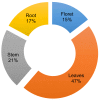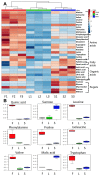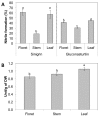Comparative Phytonutrient Analysis of Broccoli By-Products: The Potentials for Broccoli By-Product Utilization
- PMID: 29652847
- PMCID: PMC6017511
- DOI: 10.3390/molecules23040900
Comparative Phytonutrient Analysis of Broccoli By-Products: The Potentials for Broccoli By-Product Utilization
Abstract
The phytonutrient concentrations of broccoli (Brassica oleracea var. italica) florets, stems, and leaves were compared to evaluate the value of stem and leaf by-products as a source of valuable nutrients. Primary metabolites, including amino acids, organic acids, and sugars, as well as glucosinolates, carotenoids, chlorophylls, vitamins E and K, essential mineral elements, total phenolic content, antioxidant activity, and expression of glucosinolate biosynthesis and hydrolysis genes were quantified from the different broccoli tissues. Broccoli florets had higher concentrations of amino acids, glucoraphanin, and neoglucobrassicin compared to other tissues, whereas leaves were higher in carotenoids, chlorophylls, vitamins E and K, total phenolic content, and antioxidant activity. Leaves were also good sources of calcium and manganese compared to other tissues. Stems had the lowest nitrile formation from glucosinolate. Each tissue exhibited specific core gene expression profiles supporting glucosinolate metabolism, with different gene homologs expressed in florets, stems, and leaves, which suggests that tissue-specific pathways function to support primary and secondary metabolic pathways in broccoli. This comprehensive nutrient and bioactive compound profile represents a useful resource for the evaluation of broccoli by-product utilization in the human diet, and as feedstocks for bioactive compounds for industry.
Keywords: antioxidant activity; broccoli; by-products; carotenoid; chlorophyll; glucosinolates; mineral; phenolic compounds; vitamins E and K.
Conflict of interest statement
The authors declare no conflict of interest.
Figures







References
-
- Maggioni L. Ph.D. Thesis. Swedish University of Agricultural Sciences; Alnarp, Sweden: 2015. Domestication of Brassica oleracea L.
-
- Shiva R.B., Jung-Ho K. Seasonal variation in phytochemicals and antioxidant activities in different tissues of various broccoli cultivars. Afr. J. Biotechnol. 2014;13:604–615. doi: 10.5897/AJB2013.13432. - DOI
Publication types
MeSH terms
Substances
LinkOut - more resources
Full Text Sources
Other Literature Sources

